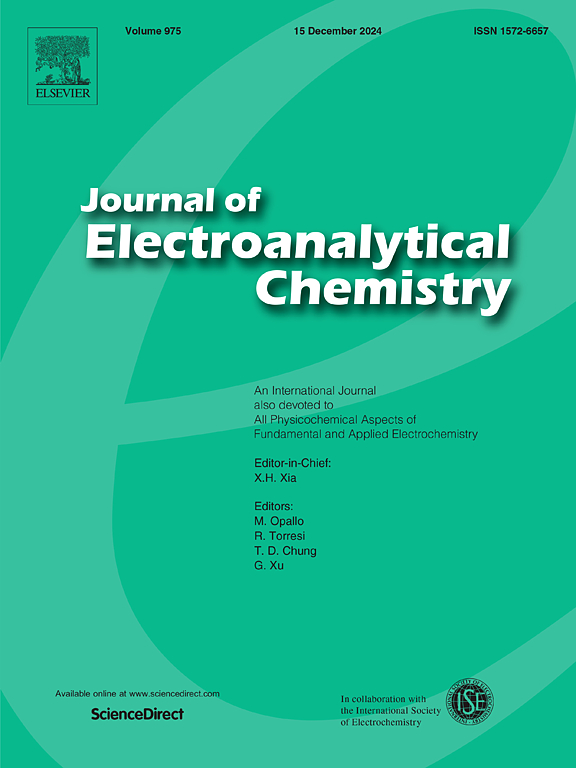碳包覆非化学计量TiOx在锂离子电池阳极快速充电中的应用——原位XRD研究
IF 4.1
3区 化学
Q1 CHEMISTRY, ANALYTICAL
引用次数: 0
摘要
锂离子电池因其高比容量而成为电动汽车的一种有前途的解决方案。然而,常用的碳阳极的高倍率性能较差,限制了其广泛应用。本文采用两步退火法合成了碳包被的非化学计量TiOx (C@TiO1.944)纳米粉末。电池性能表明,C@TiO1.944电极在71.5% ICE条件下具有246.3 mAh/g的显著初始容量,在100% CE条件下在0.2C速率下保持166.2 mAh/g,在5C条件下保持109.0 mAh/g。相比之下,TiOx电池的初始容量为264.3 mAh/g, ICE为67.4%,在相同倍率下保持156.6 mAh/g,在5C放电倍率下保持79.2 mAh/g。此外,利用恒电位仪进行了x射线原位衍射(XRD)实验,以阐明反应机理,从而实时跟踪充放电过程中的相变。当锂离子插入金红石型TiO2基体时,碳涂层可以保护内部TiOx核心不发生相变和晶格畸变。金红石型TiO2的Li储存机制表明其不发生相变,这是其具有高库仑效率的额外证据。此外,碳涂层通过防止Li离子死亡而保持在锐钛矿相来提高库仑效率。结果表明,碳包覆的非化学计量TiO2 (C@TiOx)将成为锂离子电池快速充电的一种解决方案。本文章由计算机程序翻译,如有差异,请以英文原文为准。
Carbon-coated nonstoichiometric TiOx for application of Li-ion battery anodes in fast charging-in situ XRD study
Lithium-ion batteries have emerged as a promising solution for electric vehicles, owing to their high specific capacity. However, the commonly used carbon anodes suffer from poor high-rate capability, which restricts their wider application. In this work carbon-coated nonstoichiometric TiOx (C@TiO1.944) nanopowder was synthesized using a two-step annealing method. The performances of batteries show that the C@TiO1.944 electrode has a remarkable initial capacity of 246.3 mAh/g with 71.5 % ICE and retains 166.2 mAh/g at a rate of 0.2C with 100 % CE and 109.0 mAh/g at 5C after formation. In contrast, the TiOx battery's initial capacity is 264.3 mAh/g with a 67.4 % ICE with a retention of 156.6 mAh/g at the same rate and 79.2 mAh/g at a discharge rate of 5C. Additionally, in situ X-ray diffraction (XRD) experiments was conducted with a potentiostat for elucidating the reaction mechanism which enables to track the phase transition in real-time during charge and discharge. The carbon coating protects the inner TiOx core from phase transition and lattice distortion occurs when Li ions are intercalated in the rutile TiO2 matrix. The Li storage mechanism of rutile TiO2 indicates it is not phase-transformed that can be taken as extra evidence for the high Coulombic efficiency. Further, the carbon coating enhanced the Coulombic efficiency by preventing dead Li ions while retaining in the anatase phase. The results shows that carbon-coated nonstoichiometric TiO2 (C@TiOx) used in LIBs will be a solution for rapid charge application.
求助全文
通过发布文献求助,成功后即可免费获取论文全文。
去求助
来源期刊
CiteScore
7.80
自引率
6.70%
发文量
912
审稿时长
2.4 months
期刊介绍:
The Journal of Electroanalytical Chemistry is the foremost international journal devoted to the interdisciplinary subject of electrochemistry in all its aspects, theoretical as well as applied.
Electrochemistry is a wide ranging area that is in a state of continuous evolution. Rather than compiling a long list of topics covered by the Journal, the editors would like to draw particular attention to the key issues of novelty, topicality and quality. Papers should present new and interesting electrochemical science in a way that is accessible to the reader. The presentation and discussion should be at a level that is consistent with the international status of the Journal. Reports describing the application of well-established techniques to problems that are essentially technical will not be accepted. Similarly, papers that report observations but fail to provide adequate interpretation will be rejected by the Editors. Papers dealing with technical electrochemistry should be submitted to other specialist journals unless the authors can show that their work provides substantially new insights into electrochemical processes.

 求助内容:
求助内容: 应助结果提醒方式:
应助结果提醒方式:


